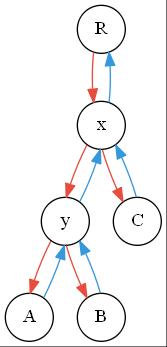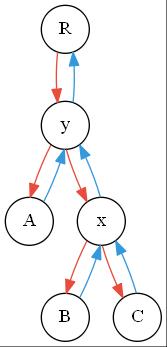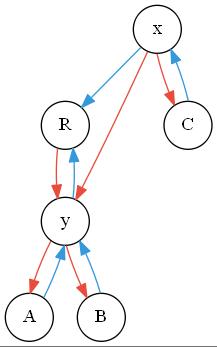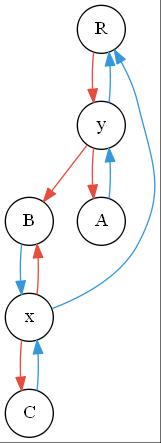Splay
Splay最主要的一点是它能反转区间,而Treap以及替罪羊不能,这也是为什么它作为Link Cut Tree的辅助树。
框架
首先需要写一个这样的程序框架:1
2
3
4
5
6
7
8
9
10
11
12
13
14
15
16
17
18
19
20
21
22
23
24
25
26
27
28
29
30
31
32
33
34
35
36
37
using namespace std;
typedef int ll;
const ll MAXN=2e5+51;
inline ll read()
{
register ll num=0,neg=1;
register char ch=getchar();
while(!isdigit(ch)&&ch!='-')
{
ch=getchar();
}
if(ch=='-')
{
neg=-1;
ch=getchar();
}
while(isdigit(ch))
{
num=(num<<3)+(num<<1)+(ch-'0');
ch=getchar();
}
return num*neg;
}
ll cnt,qcnt,l,r;
namespace Splay{
struct Node{
ll fa,val,size,tag;
ll ch[2];
};
struct Splay{
ll tot,root;
Node nd[MAXN];
//Code goes here
};
}
以下代码片段全部接在注释处。
基本操作
首先是$update$,用于更新节点的$size$。
既然写过线段树,那么这个操作应该不难。1
2
3
4inline void update(ll x)
{
nd[x].size=nd[nd[x].ch[0]].size+nd[nd[x].ch[1]].size+1;
}
接下来是$id$,用于判断一个节点是它的父亲的哪一个孩子。
这个很简单,只需要几行代码。1
2
3
4inline bool id(ll x)
{
return nd[nd[x].fa].ch[1]==x;
}
下一个是$connect$,用于建立新的父子关系,这个也不难。1
2
3
4inline void connect(ll x,ll fa,ll dir)
{
nd[x].fa=fa,nd[fa].ch[dir]=x;
}
关键操作
以下两个操作是旋转操作,很关键,而且不好调。
首先是$rotate$,用于平衡旋转。
举个栗子,这是原来的平衡树。
其中蓝色指向父亲,红色指向儿子。
调用$rotate(y)$之后,平衡树就变成这个样子了:
由于之前$connect$的实现,这个就变得不难了,因为旋转依次要改变$3$对父子关系。
第一对,对照第二幅图可以发现,可以直接在$y$与$R$建立关系,就像这样
第二对,在$B$与$x$之间建立父子关系,然后就变成了这个
最后,在$x$与$y$建立父子关系就大功告成啦qwq。
所以,上代码1
2
3
4
5
6
7
8inline void rotate(ll x)
{
ll fa=nd[x].fa,gfa=nd[fa].fa,dir=id(x);
connect(x,gfa,id(fa));
connect(nd[x].ch[dir^1],fa,dir);
connect(fa,x,dir^1);
update(fa),update(x);
}
还有一个是$splay$,这个尽管代码不长,但是很难调。
我不推荐直接上旋,因为这样可能会很慢。1
2
3
4
5
6
7
8
9
10
11
12
13
14
15
16inline void splay(ll cur,ll target)
{
while(nd[cur].fa!=target)
{
ll fa=nd[cur].fa,gfa=nd[fa].fa;
if(gfa!=target)
{
rotate(id(cur)^id(fa)?cur:fa);
}
rotate(cur);
}
if(!target)
{
root=cur;
}
}